Finance Report: Analysis of the Hospitality Industry in the UK
VerifiedAdded on 2020/02/03
|23
|6180
|453
Report
AI Summary
This report provides a comprehensive financial analysis of the hospitality industry, focusing on key aspects such as sources of finance, revenue generation, cost components, and inventory and cash management. It delves into various methods for increasing revenue, including differentiated products and services, promotions, and commissions. The report examines different components of cost, gross profit, and selling prices, offering insights into how to control stock and cash within a business. Furthermore, it discusses budgeting processes, variance analysis, and the assessment of trial balances. It also covers the calculation and analysis of financial ratios, along with recommendations for future management strategies. The report explores the classification of costs as fixed, variable, and semi-variable, while calculating contribution per customer and explaining the cost-volume-profit relationship. Finally, it offers justification for short-term management decisions based on financial data and analysis. This report is a student contribution available on Desklib, a platform offering AI-based study tools.
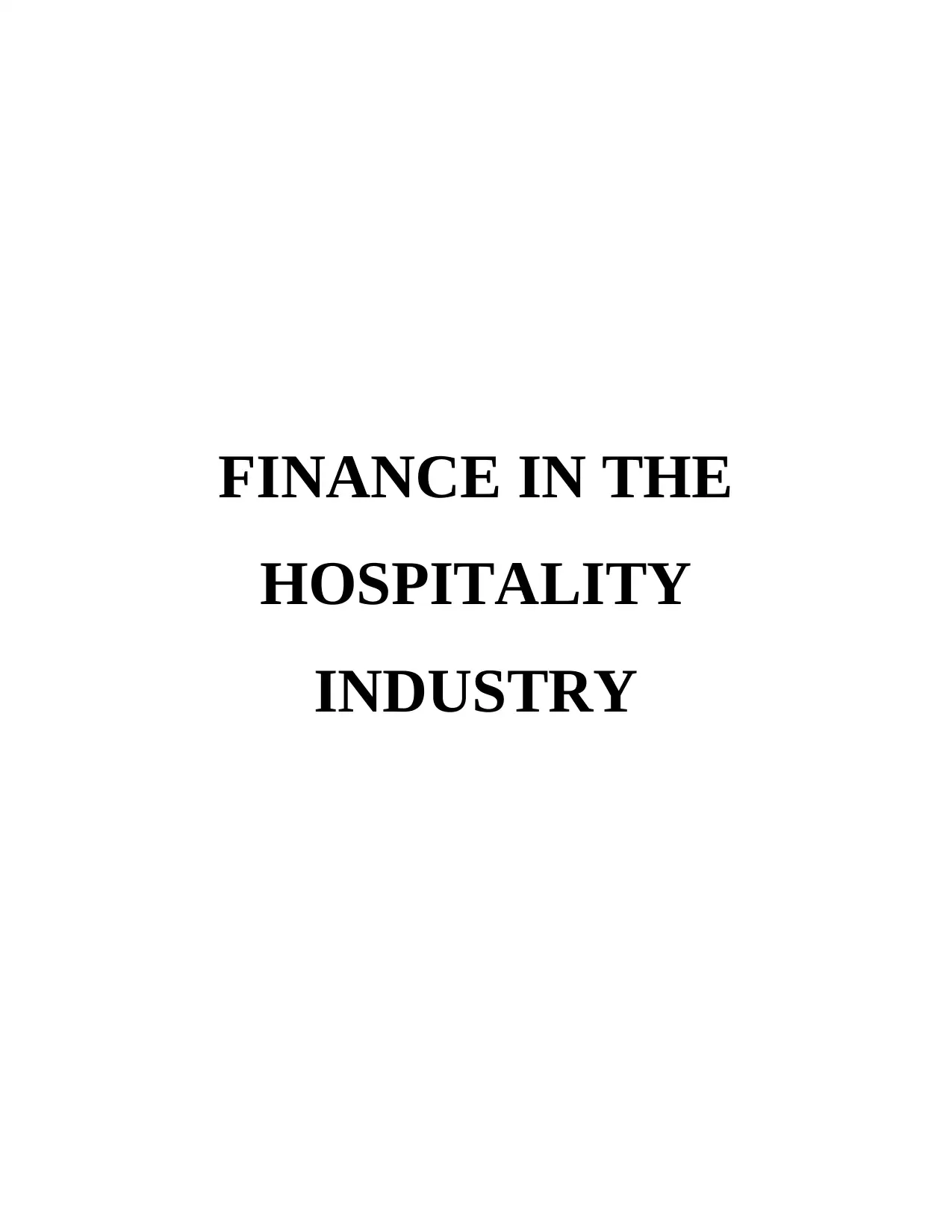
FINANCE IN THE
HOSPITALITY
INDUSTRY
HOSPITALITY
INDUSTRY
Paraphrase This Document
Need a fresh take? Get an instant paraphrase of this document with our AI Paraphraser
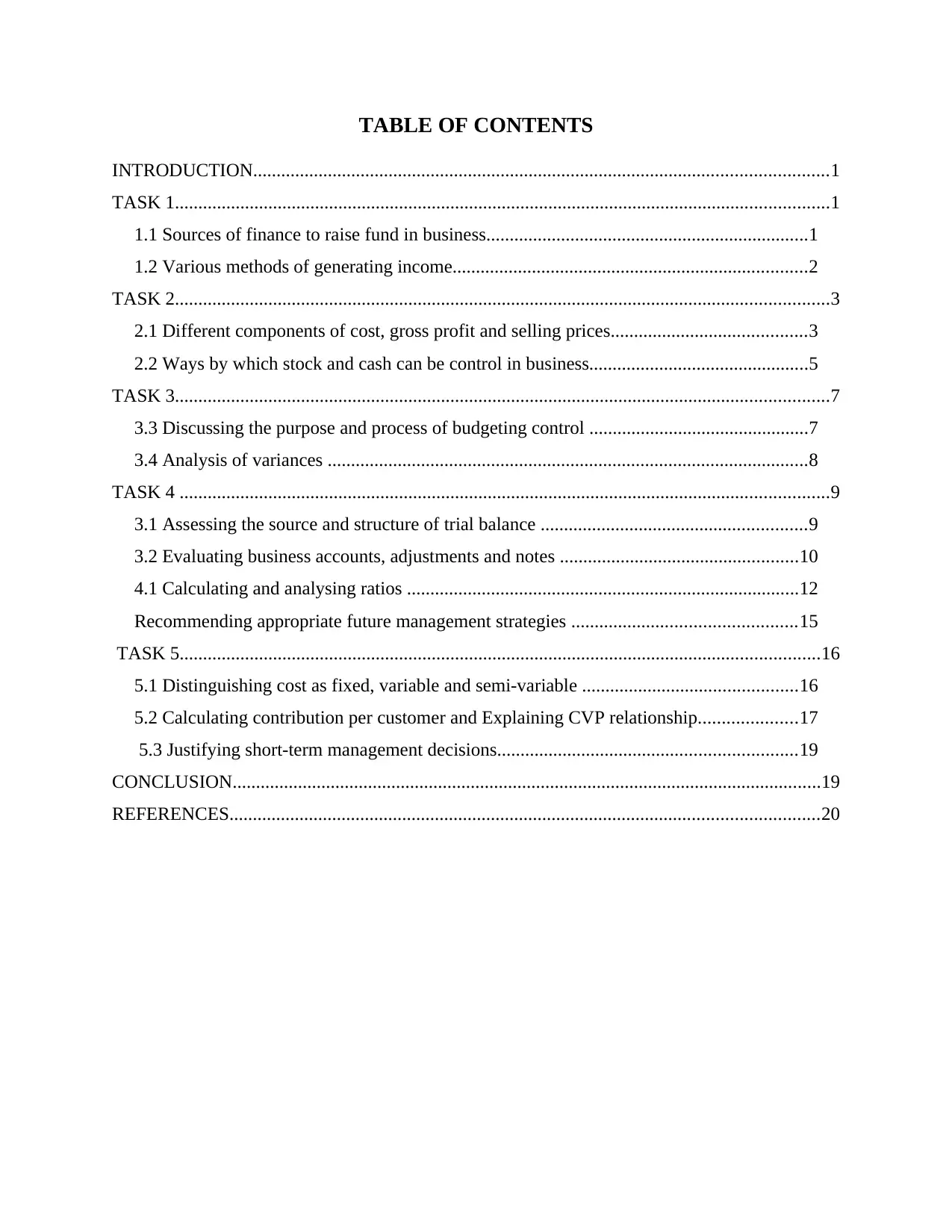
TABLE OF CONTENTS
INTRODUCTION...........................................................................................................................1
TASK 1............................................................................................................................................1
1.1 Sources of finance to raise fund in business.....................................................................1
1.2 Various methods of generating income............................................................................2
TASK 2............................................................................................................................................3
2.1 Different components of cost, gross profit and selling prices..........................................3
2.2 Ways by which stock and cash can be control in business...............................................5
TASK 3............................................................................................................................................7
3.3 Discussing the purpose and process of budgeting control ...............................................7
3.4 Analysis of variances .......................................................................................................8
TASK 4 ...........................................................................................................................................9
3.1 Assessing the source and structure of trial balance .........................................................9
3.2 Evaluating business accounts, adjustments and notes ...................................................10
4.1 Calculating and analysing ratios ....................................................................................12
Recommending appropriate future management strategies ................................................15
TASK 5.........................................................................................................................................16
5.1 Distinguishing cost as fixed, variable and semi-variable ..............................................16
5.2 Calculating contribution per customer and Explaining CVP relationship.....................17
5.3 Justifying short-term management decisions................................................................19
CONCLUSION..............................................................................................................................19
REFERENCES..............................................................................................................................20
INTRODUCTION...........................................................................................................................1
TASK 1............................................................................................................................................1
1.1 Sources of finance to raise fund in business.....................................................................1
1.2 Various methods of generating income............................................................................2
TASK 2............................................................................................................................................3
2.1 Different components of cost, gross profit and selling prices..........................................3
2.2 Ways by which stock and cash can be control in business...............................................5
TASK 3............................................................................................................................................7
3.3 Discussing the purpose and process of budgeting control ...............................................7
3.4 Analysis of variances .......................................................................................................8
TASK 4 ...........................................................................................................................................9
3.1 Assessing the source and structure of trial balance .........................................................9
3.2 Evaluating business accounts, adjustments and notes ...................................................10
4.1 Calculating and analysing ratios ....................................................................................12
Recommending appropriate future management strategies ................................................15
TASK 5.........................................................................................................................................16
5.1 Distinguishing cost as fixed, variable and semi-variable ..............................................16
5.2 Calculating contribution per customer and Explaining CVP relationship.....................17
5.3 Justifying short-term management decisions................................................................19
CONCLUSION..............................................................................................................................19
REFERENCES..............................................................................................................................20
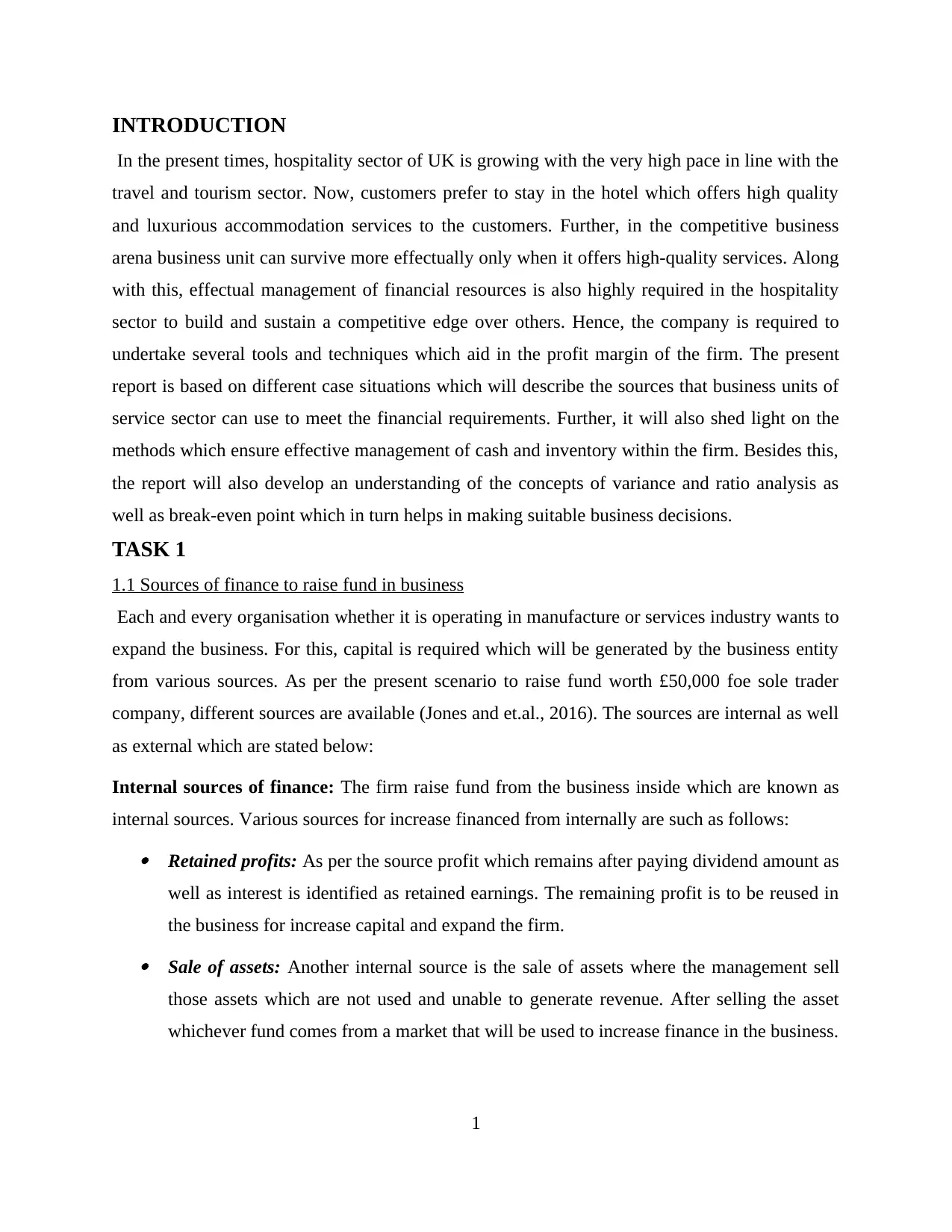
INTRODUCTION
In the present times, hospitality sector of UK is growing with the very high pace in line with the
travel and tourism sector. Now, customers prefer to stay in the hotel which offers high quality
and luxurious accommodation services to the customers. Further, in the competitive business
arena business unit can survive more effectually only when it offers high-quality services. Along
with this, effectual management of financial resources is also highly required in the hospitality
sector to build and sustain a competitive edge over others. Hence, the company is required to
undertake several tools and techniques which aid in the profit margin of the firm. The present
report is based on different case situations which will describe the sources that business units of
service sector can use to meet the financial requirements. Further, it will also shed light on the
methods which ensure effective management of cash and inventory within the firm. Besides this,
the report will also develop an understanding of the concepts of variance and ratio analysis as
well as break-even point which in turn helps in making suitable business decisions.
TASK 1
1.1 Sources of finance to raise fund in business
Each and every organisation whether it is operating in manufacture or services industry wants to
expand the business. For this, capital is required which will be generated by the business entity
from various sources. As per the present scenario to raise fund worth £50,000 foe sole trader
company, different sources are available (Jones and et.al., 2016). The sources are internal as well
as external which are stated below:
Internal sources of finance: The firm raise fund from the business inside which are known as
internal sources. Various sources for increase financed from internally are such as follows: Retained profits: As per the source profit which remains after paying dividend amount as
well as interest is identified as retained earnings. The remaining profit is to be reused in
the business for increase capital and expand the firm. Sale of assets: Another internal source is the sale of assets where the management sell
those assets which are not used and unable to generate revenue. After selling the asset
whichever fund comes from a market that will be used to increase finance in the business.
1
In the present times, hospitality sector of UK is growing with the very high pace in line with the
travel and tourism sector. Now, customers prefer to stay in the hotel which offers high quality
and luxurious accommodation services to the customers. Further, in the competitive business
arena business unit can survive more effectually only when it offers high-quality services. Along
with this, effectual management of financial resources is also highly required in the hospitality
sector to build and sustain a competitive edge over others. Hence, the company is required to
undertake several tools and techniques which aid in the profit margin of the firm. The present
report is based on different case situations which will describe the sources that business units of
service sector can use to meet the financial requirements. Further, it will also shed light on the
methods which ensure effective management of cash and inventory within the firm. Besides this,
the report will also develop an understanding of the concepts of variance and ratio analysis as
well as break-even point which in turn helps in making suitable business decisions.
TASK 1
1.1 Sources of finance to raise fund in business
Each and every organisation whether it is operating in manufacture or services industry wants to
expand the business. For this, capital is required which will be generated by the business entity
from various sources. As per the present scenario to raise fund worth £50,000 foe sole trader
company, different sources are available (Jones and et.al., 2016). The sources are internal as well
as external which are stated below:
Internal sources of finance: The firm raise fund from the business inside which are known as
internal sources. Various sources for increase financed from internally are such as follows: Retained profits: As per the source profit which remains after paying dividend amount as
well as interest is identified as retained earnings. The remaining profit is to be reused in
the business for increase capital and expand the firm. Sale of assets: Another internal source is the sale of assets where the management sell
those assets which are not used and unable to generate revenue. After selling the asset
whichever fund comes from a market that will be used to increase finance in the business.
1
⊘ This is a preview!⊘
Do you want full access?
Subscribe today to unlock all pages.

Trusted by 1+ million students worldwide
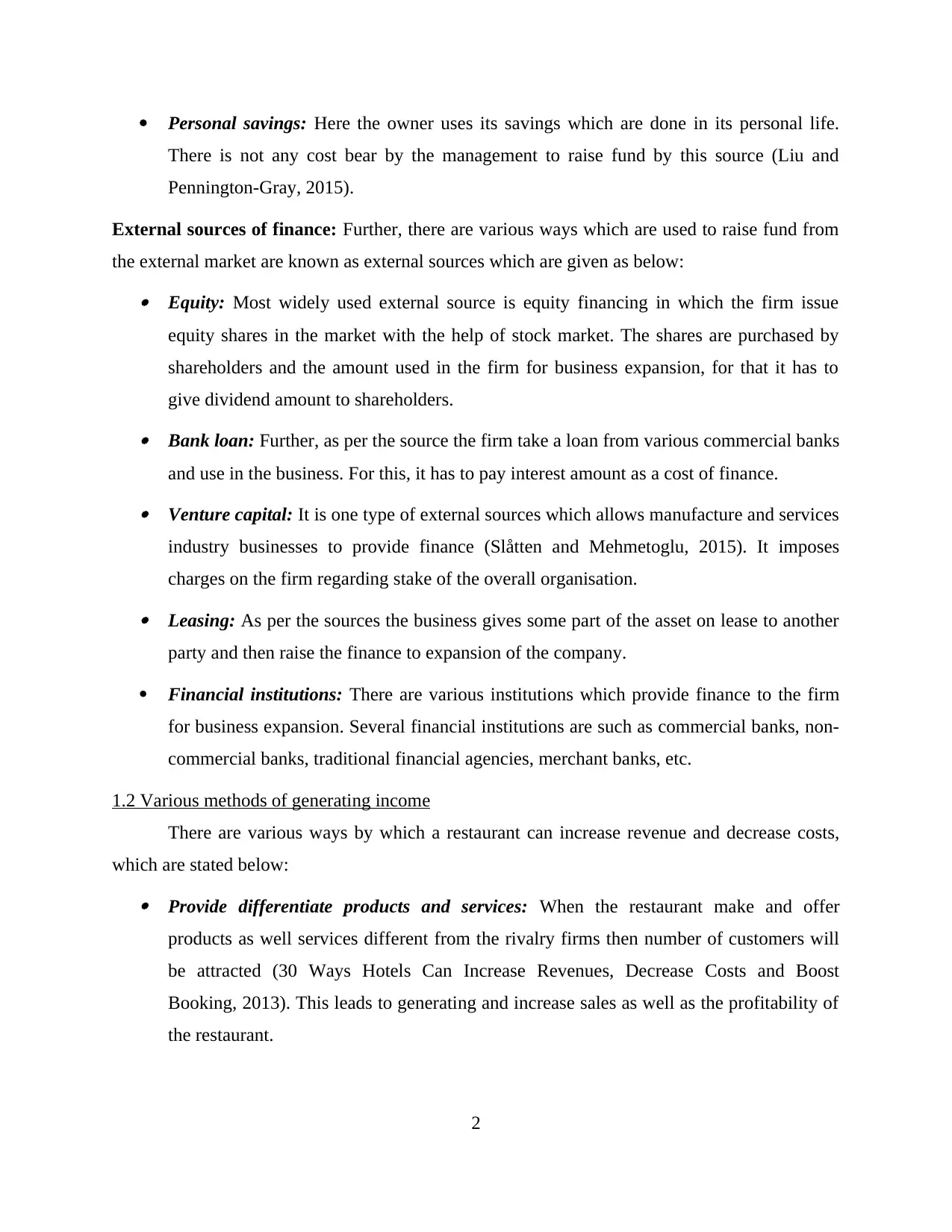
Personal savings: Here the owner uses its savings which are done in its personal life.
There is not any cost bear by the management to raise fund by this source (Liu and
Pennington-Gray, 2015).
External sources of finance: Further, there are various ways which are used to raise fund from
the external market are known as external sources which are given as below: Equity: Most widely used external source is equity financing in which the firm issue
equity shares in the market with the help of stock market. The shares are purchased by
shareholders and the amount used in the firm for business expansion, for that it has to
give dividend amount to shareholders. Bank loan: Further, as per the source the firm take a loan from various commercial banks
and use in the business. For this, it has to pay interest amount as a cost of finance. Venture capital: It is one type of external sources which allows manufacture and services
industry businesses to provide finance (Slåtten and Mehmetoglu, 2015). It imposes
charges on the firm regarding stake of the overall organisation. Leasing: As per the sources the business gives some part of the asset on lease to another
party and then raise the finance to expansion of the company.
Financial institutions: There are various institutions which provide finance to the firm
for business expansion. Several financial institutions are such as commercial banks, non-
commercial banks, traditional financial agencies, merchant banks, etc.
1.2 Various methods of generating income
There are various ways by which a restaurant can increase revenue and decrease costs,
which are stated below: Provide differentiate products and services: When the restaurant make and offer
products as well services different from the rivalry firms then number of customers will
be attracted (30 Ways Hotels Can Increase Revenues, Decrease Costs and Boost
Booking, 2013). This leads to generating and increase sales as well as the profitability of
the restaurant.
2
There is not any cost bear by the management to raise fund by this source (Liu and
Pennington-Gray, 2015).
External sources of finance: Further, there are various ways which are used to raise fund from
the external market are known as external sources which are given as below: Equity: Most widely used external source is equity financing in which the firm issue
equity shares in the market with the help of stock market. The shares are purchased by
shareholders and the amount used in the firm for business expansion, for that it has to
give dividend amount to shareholders. Bank loan: Further, as per the source the firm take a loan from various commercial banks
and use in the business. For this, it has to pay interest amount as a cost of finance. Venture capital: It is one type of external sources which allows manufacture and services
industry businesses to provide finance (Slåtten and Mehmetoglu, 2015). It imposes
charges on the firm regarding stake of the overall organisation. Leasing: As per the sources the business gives some part of the asset on lease to another
party and then raise the finance to expansion of the company.
Financial institutions: There are various institutions which provide finance to the firm
for business expansion. Several financial institutions are such as commercial banks, non-
commercial banks, traditional financial agencies, merchant banks, etc.
1.2 Various methods of generating income
There are various ways by which a restaurant can increase revenue and decrease costs,
which are stated below: Provide differentiate products and services: When the restaurant make and offer
products as well services different from the rivalry firms then number of customers will
be attracted (30 Ways Hotels Can Increase Revenues, Decrease Costs and Boost
Booking, 2013). This leads to generating and increase sales as well as the profitability of
the restaurant.
2
Paraphrase This Document
Need a fresh take? Get an instant paraphrase of this document with our AI Paraphraser
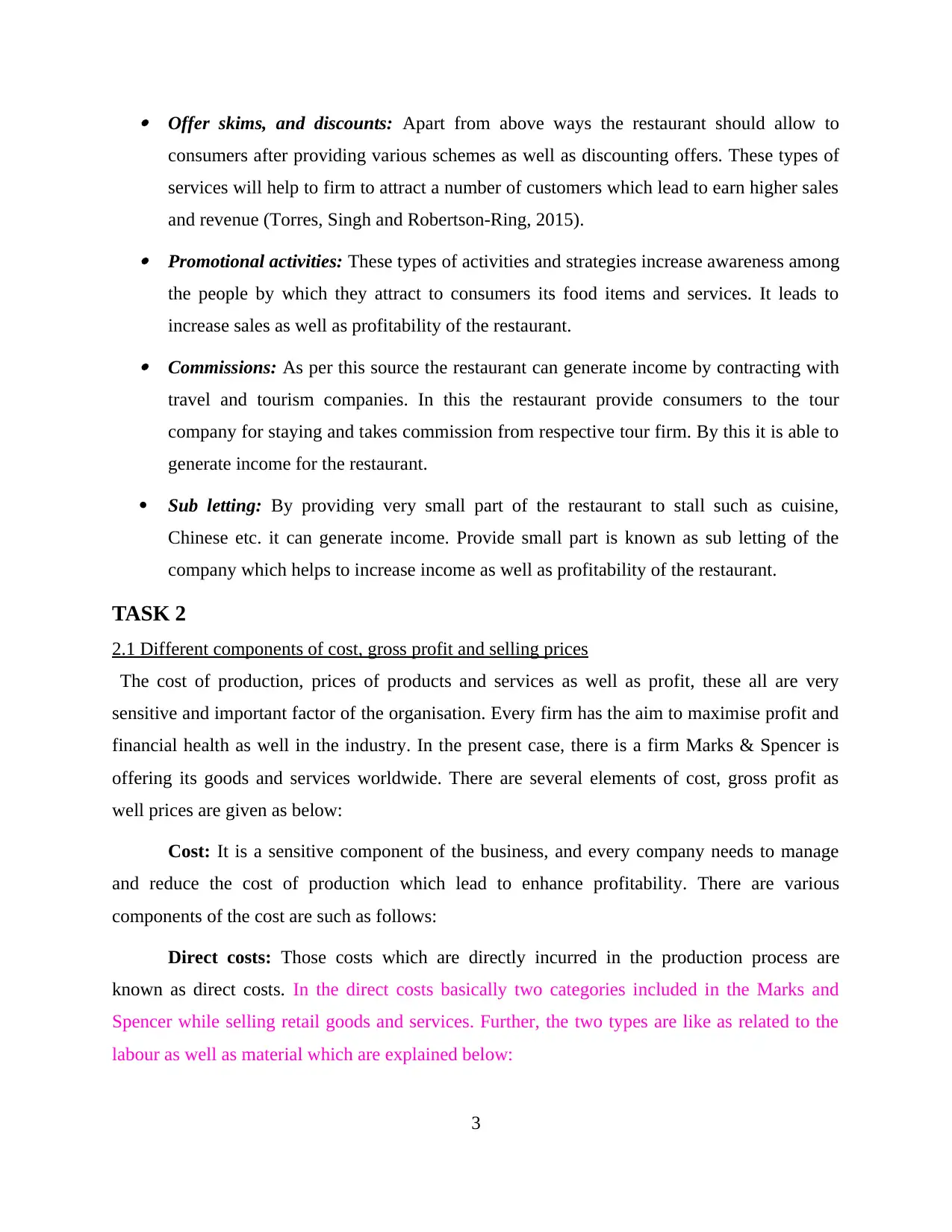
Offer skims, and discounts: Apart from above ways the restaurant should allow to
consumers after providing various schemes as well as discounting offers. These types of
services will help to firm to attract a number of customers which lead to earn higher sales
and revenue (Torres, Singh and Robertson-Ring, 2015). Promotional activities: These types of activities and strategies increase awareness among
the people by which they attract to consumers its food items and services. It leads to
increase sales as well as profitability of the restaurant. Commissions: As per this source the restaurant can generate income by contracting with
travel and tourism companies. In this the restaurant provide consumers to the tour
company for staying and takes commission from respective tour firm. By this it is able to
generate income for the restaurant.
Sub letting: By providing very small part of the restaurant to stall such as cuisine,
Chinese etc. it can generate income. Provide small part is known as sub letting of the
company which helps to increase income as well as profitability of the restaurant.
TASK 2
2.1 Different components of cost, gross profit and selling prices
The cost of production, prices of products and services as well as profit, these all are very
sensitive and important factor of the organisation. Every firm has the aim to maximise profit and
financial health as well in the industry. In the present case, there is a firm Marks & Spencer is
offering its goods and services worldwide. There are several elements of cost, gross profit as
well prices are given as below:
Cost: It is a sensitive component of the business, and every company needs to manage
and reduce the cost of production which lead to enhance profitability. There are various
components of the cost are such as follows:
Direct costs: Those costs which are directly incurred in the production process are
known as direct costs. In the direct costs basically two categories included in the Marks and
Spencer while selling retail goods and services. Further, the two types are like as related to the
labour as well as material which are explained below:
3
consumers after providing various schemes as well as discounting offers. These types of
services will help to firm to attract a number of customers which lead to earn higher sales
and revenue (Torres, Singh and Robertson-Ring, 2015). Promotional activities: These types of activities and strategies increase awareness among
the people by which they attract to consumers its food items and services. It leads to
increase sales as well as profitability of the restaurant. Commissions: As per this source the restaurant can generate income by contracting with
travel and tourism companies. In this the restaurant provide consumers to the tour
company for staying and takes commission from respective tour firm. By this it is able to
generate income for the restaurant.
Sub letting: By providing very small part of the restaurant to stall such as cuisine,
Chinese etc. it can generate income. Provide small part is known as sub letting of the
company which helps to increase income as well as profitability of the restaurant.
TASK 2
2.1 Different components of cost, gross profit and selling prices
The cost of production, prices of products and services as well as profit, these all are very
sensitive and important factor of the organisation. Every firm has the aim to maximise profit and
financial health as well in the industry. In the present case, there is a firm Marks & Spencer is
offering its goods and services worldwide. There are several elements of cost, gross profit as
well prices are given as below:
Cost: It is a sensitive component of the business, and every company needs to manage
and reduce the cost of production which lead to enhance profitability. There are various
components of the cost are such as follows:
Direct costs: Those costs which are directly incurred in the production process are
known as direct costs. In the direct costs basically two categories included in the Marks and
Spencer while selling retail goods and services. Further, the two types are like as related to the
labour as well as material which are explained below:
3
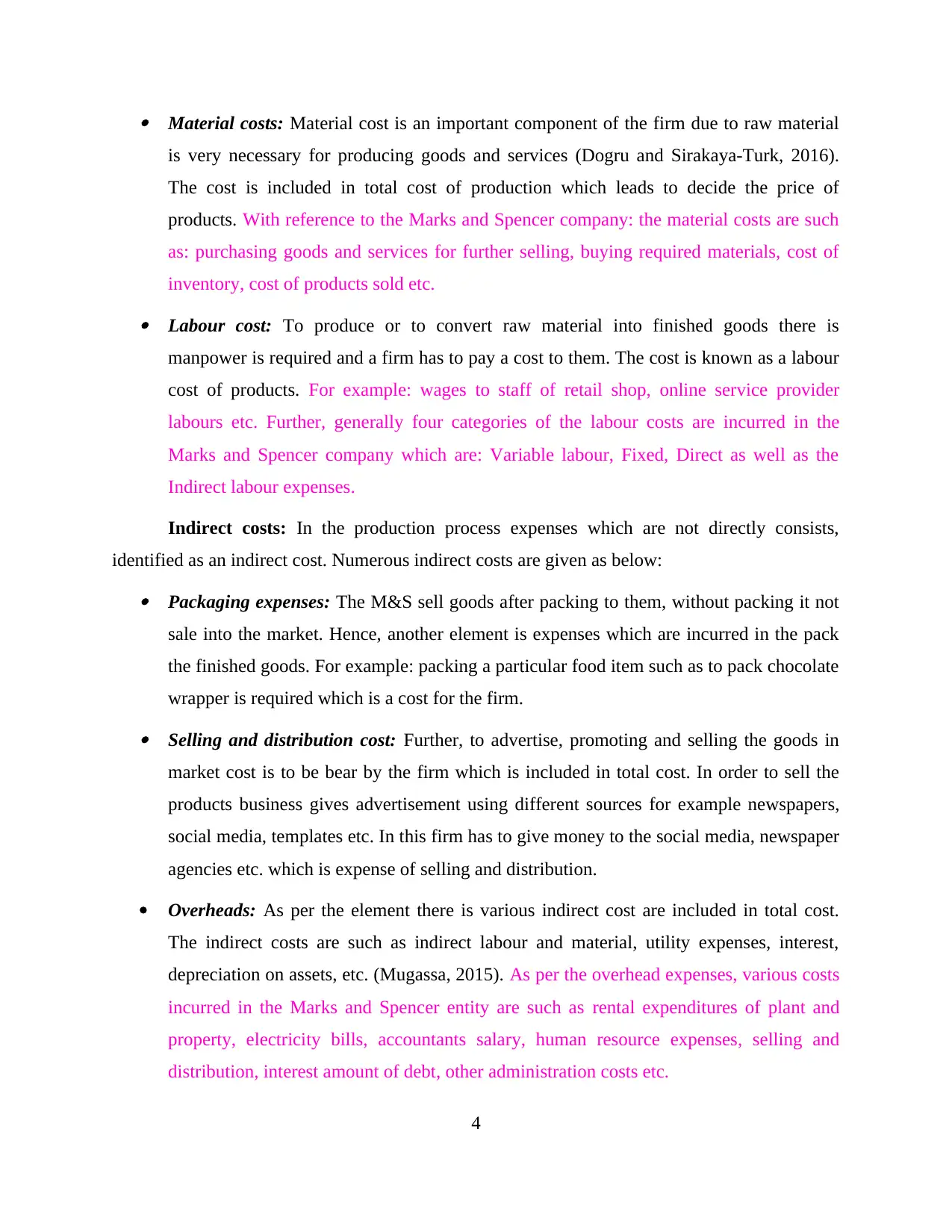
Material costs: Material cost is an important component of the firm due to raw material
is very necessary for producing goods and services (Dogru and Sirakaya-Turk, 2016).
The cost is included in total cost of production which leads to decide the price of
products. With reference to the Marks and Spencer company: the material costs are such
as: purchasing goods and services for further selling, buying required materials, cost of
inventory, cost of products sold etc. Labour cost: To produce or to convert raw material into finished goods there is
manpower is required and a firm has to pay a cost to them. The cost is known as a labour
cost of products. For example: wages to staff of retail shop, online service provider
labours etc. Further, generally four categories of the labour costs are incurred in the
Marks and Spencer company which are: Variable labour, Fixed, Direct as well as the
Indirect labour expenses.
Indirect costs: In the production process expenses which are not directly consists,
identified as an indirect cost. Numerous indirect costs are given as below: Packaging expenses: The M&S sell goods after packing to them, without packing it not
sale into the market. Hence, another element is expenses which are incurred in the pack
the finished goods. For example: packing a particular food item such as to pack chocolate
wrapper is required which is a cost for the firm. Selling and distribution cost: Further, to advertise, promoting and selling the goods in
market cost is to be bear by the firm which is included in total cost. In order to sell the
products business gives advertisement using different sources for example newspapers,
social media, templates etc. In this firm has to give money to the social media, newspaper
agencies etc. which is expense of selling and distribution.
Overheads: As per the element there is various indirect cost are included in total cost.
The indirect costs are such as indirect labour and material, utility expenses, interest,
depreciation on assets, etc. (Mugassa, 2015). As per the overhead expenses, various costs
incurred in the Marks and Spencer entity are such as rental expenditures of plant and
property, electricity bills, accountants salary, human resource expenses, selling and
distribution, interest amount of debt, other administration costs etc.
4
is very necessary for producing goods and services (Dogru and Sirakaya-Turk, 2016).
The cost is included in total cost of production which leads to decide the price of
products. With reference to the Marks and Spencer company: the material costs are such
as: purchasing goods and services for further selling, buying required materials, cost of
inventory, cost of products sold etc. Labour cost: To produce or to convert raw material into finished goods there is
manpower is required and a firm has to pay a cost to them. The cost is known as a labour
cost of products. For example: wages to staff of retail shop, online service provider
labours etc. Further, generally four categories of the labour costs are incurred in the
Marks and Spencer company which are: Variable labour, Fixed, Direct as well as the
Indirect labour expenses.
Indirect costs: In the production process expenses which are not directly consists,
identified as an indirect cost. Numerous indirect costs are given as below: Packaging expenses: The M&S sell goods after packing to them, without packing it not
sale into the market. Hence, another element is expenses which are incurred in the pack
the finished goods. For example: packing a particular food item such as to pack chocolate
wrapper is required which is a cost for the firm. Selling and distribution cost: Further, to advertise, promoting and selling the goods in
market cost is to be bear by the firm which is included in total cost. In order to sell the
products business gives advertisement using different sources for example newspapers,
social media, templates etc. In this firm has to give money to the social media, newspaper
agencies etc. which is expense of selling and distribution.
Overheads: As per the element there is various indirect cost are included in total cost.
The indirect costs are such as indirect labour and material, utility expenses, interest,
depreciation on assets, etc. (Mugassa, 2015). As per the overhead expenses, various costs
incurred in the Marks and Spencer entity are such as rental expenditures of plant and
property, electricity bills, accountants salary, human resource expenses, selling and
distribution, interest amount of debt, other administration costs etc.
4
⊘ This is a preview!⊘
Do you want full access?
Subscribe today to unlock all pages.

Trusted by 1+ million students worldwide
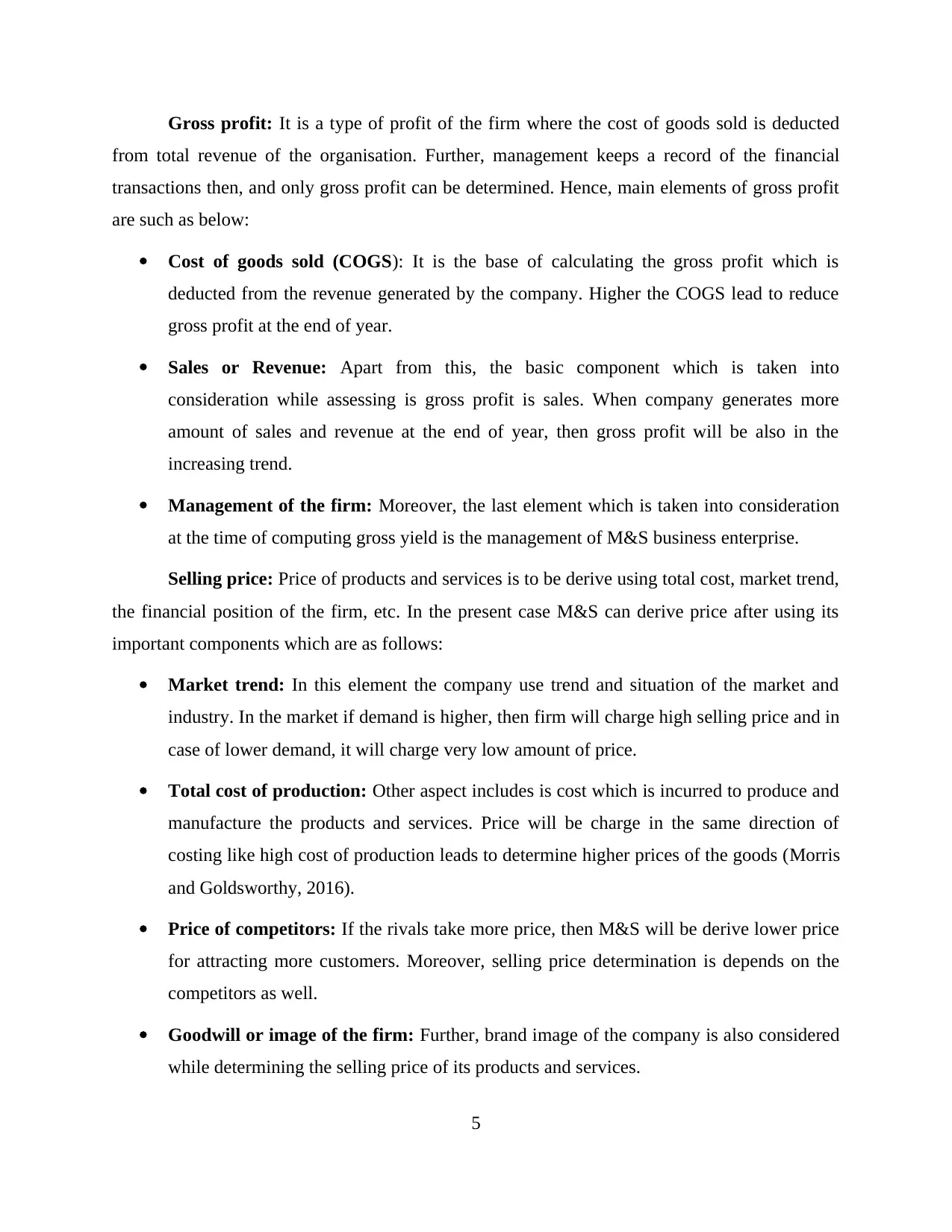
Gross profit: It is a type of profit of the firm where the cost of goods sold is deducted
from total revenue of the organisation. Further, management keeps a record of the financial
transactions then, and only gross profit can be determined. Hence, main elements of gross profit
are such as below:
Cost of goods sold (COGS): It is the base of calculating the gross profit which is
deducted from the revenue generated by the company. Higher the COGS lead to reduce
gross profit at the end of year.
Sales or Revenue: Apart from this, the basic component which is taken into
consideration while assessing is gross profit is sales. When company generates more
amount of sales and revenue at the end of year, then gross profit will be also in the
increasing trend.
Management of the firm: Moreover, the last element which is taken into consideration
at the time of computing gross yield is the management of M&S business enterprise.
Selling price: Price of products and services is to be derive using total cost, market trend,
the financial position of the firm, etc. In the present case M&S can derive price after using its
important components which are as follows:
Market trend: In this element the company use trend and situation of the market and
industry. In the market if demand is higher, then firm will charge high selling price and in
case of lower demand, it will charge very low amount of price.
Total cost of production: Other aspect includes is cost which is incurred to produce and
manufacture the products and services. Price will be charge in the same direction of
costing like high cost of production leads to determine higher prices of the goods (Morris
and Goldsworthy, 2016).
Price of competitors: If the rivals take more price, then M&S will be derive lower price
for attracting more customers. Moreover, selling price determination is depends on the
competitors as well.
Goodwill or image of the firm: Further, brand image of the company is also considered
while determining the selling price of its products and services.
5
from total revenue of the organisation. Further, management keeps a record of the financial
transactions then, and only gross profit can be determined. Hence, main elements of gross profit
are such as below:
Cost of goods sold (COGS): It is the base of calculating the gross profit which is
deducted from the revenue generated by the company. Higher the COGS lead to reduce
gross profit at the end of year.
Sales or Revenue: Apart from this, the basic component which is taken into
consideration while assessing is gross profit is sales. When company generates more
amount of sales and revenue at the end of year, then gross profit will be also in the
increasing trend.
Management of the firm: Moreover, the last element which is taken into consideration
at the time of computing gross yield is the management of M&S business enterprise.
Selling price: Price of products and services is to be derive using total cost, market trend,
the financial position of the firm, etc. In the present case M&S can derive price after using its
important components which are as follows:
Market trend: In this element the company use trend and situation of the market and
industry. In the market if demand is higher, then firm will charge high selling price and in
case of lower demand, it will charge very low amount of price.
Total cost of production: Other aspect includes is cost which is incurred to produce and
manufacture the products and services. Price will be charge in the same direction of
costing like high cost of production leads to determine higher prices of the goods (Morris
and Goldsworthy, 2016).
Price of competitors: If the rivals take more price, then M&S will be derive lower price
for attracting more customers. Moreover, selling price determination is depends on the
competitors as well.
Goodwill or image of the firm: Further, brand image of the company is also considered
while determining the selling price of its products and services.
5
Paraphrase This Document
Need a fresh take? Get an instant paraphrase of this document with our AI Paraphraser
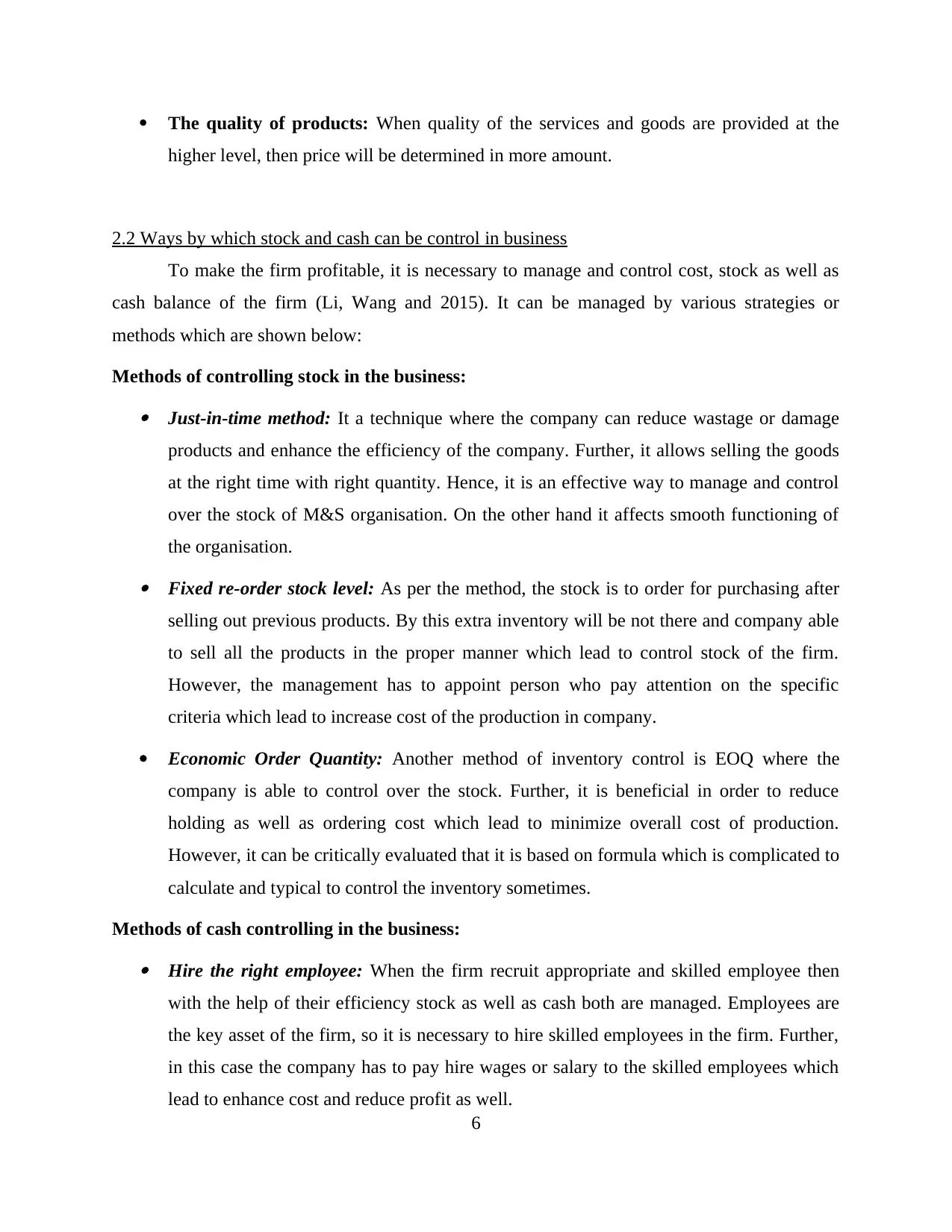
The quality of products: When quality of the services and goods are provided at the
higher level, then price will be determined in more amount.
2.2 Ways by which stock and cash can be control in business
To make the firm profitable, it is necessary to manage and control cost, stock as well as
cash balance of the firm (Li, Wang and 2015). It can be managed by various strategies or
methods which are shown below:
Methods of controlling stock in the business: Just-in-time method: It a technique where the company can reduce wastage or damage
products and enhance the efficiency of the company. Further, it allows selling the goods
at the right time with right quantity. Hence, it is an effective way to manage and control
over the stock of M&S organisation. On the other hand it affects smooth functioning of
the organisation. Fixed re-order stock level: As per the method, the stock is to order for purchasing after
selling out previous products. By this extra inventory will be not there and company able
to sell all the products in the proper manner which lead to control stock of the firm.
However, the management has to appoint person who pay attention on the specific
criteria which lead to increase cost of the production in company.
Economic Order Quantity: Another method of inventory control is EOQ where the
company is able to control over the stock. Further, it is beneficial in order to reduce
holding as well as ordering cost which lead to minimize overall cost of production.
However, it can be critically evaluated that it is based on formula which is complicated to
calculate and typical to control the inventory sometimes.
Methods of cash controlling in the business: Hire the right employee: When the firm recruit appropriate and skilled employee then
with the help of their efficiency stock as well as cash both are managed. Employees are
the key asset of the firm, so it is necessary to hire skilled employees in the firm. Further,
in this case the company has to pay hire wages or salary to the skilled employees which
lead to enhance cost and reduce profit as well.
6
higher level, then price will be determined in more amount.
2.2 Ways by which stock and cash can be control in business
To make the firm profitable, it is necessary to manage and control cost, stock as well as
cash balance of the firm (Li, Wang and 2015). It can be managed by various strategies or
methods which are shown below:
Methods of controlling stock in the business: Just-in-time method: It a technique where the company can reduce wastage or damage
products and enhance the efficiency of the company. Further, it allows selling the goods
at the right time with right quantity. Hence, it is an effective way to manage and control
over the stock of M&S organisation. On the other hand it affects smooth functioning of
the organisation. Fixed re-order stock level: As per the method, the stock is to order for purchasing after
selling out previous products. By this extra inventory will be not there and company able
to sell all the products in the proper manner which lead to control stock of the firm.
However, the management has to appoint person who pay attention on the specific
criteria which lead to increase cost of the production in company.
Economic Order Quantity: Another method of inventory control is EOQ where the
company is able to control over the stock. Further, it is beneficial in order to reduce
holding as well as ordering cost which lead to minimize overall cost of production.
However, it can be critically evaluated that it is based on formula which is complicated to
calculate and typical to control the inventory sometimes.
Methods of cash controlling in the business: Hire the right employee: When the firm recruit appropriate and skilled employee then
with the help of their efficiency stock as well as cash both are managed. Employees are
the key asset of the firm, so it is necessary to hire skilled employees in the firm. Further,
in this case the company has to pay hire wages or salary to the skilled employees which
lead to enhance cost and reduce profit as well.
6
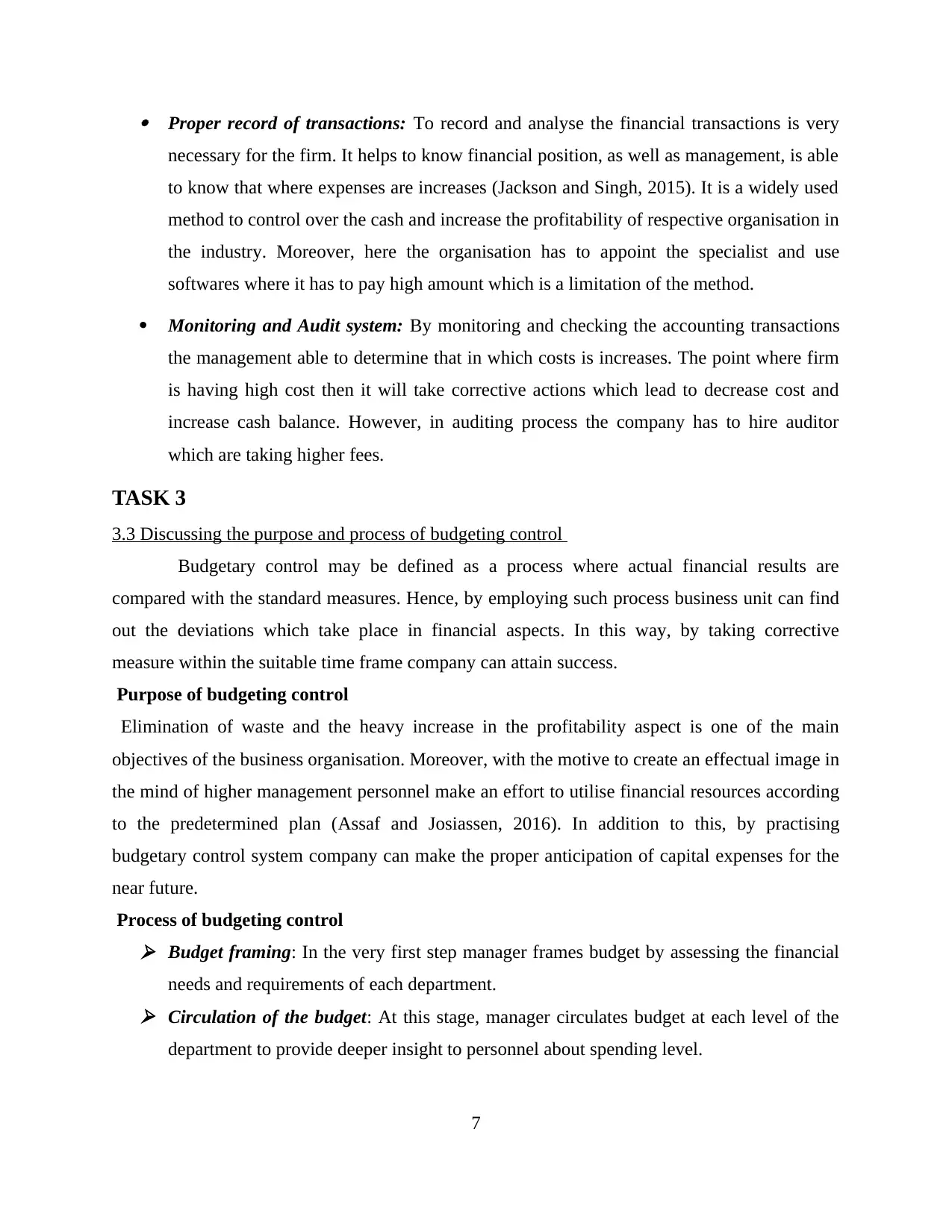
Proper record of transactions: To record and analyse the financial transactions is very
necessary for the firm. It helps to know financial position, as well as management, is able
to know that where expenses are increases (Jackson and Singh, 2015). It is a widely used
method to control over the cash and increase the profitability of respective organisation in
the industry. Moreover, here the organisation has to appoint the specialist and use
softwares where it has to pay high amount which is a limitation of the method.
Monitoring and Audit system: By monitoring and checking the accounting transactions
the management able to determine that in which costs is increases. The point where firm
is having high cost then it will take corrective actions which lead to decrease cost and
increase cash balance. However, in auditing process the company has to hire auditor
which are taking higher fees.
TASK 3
3.3 Discussing the purpose and process of budgeting control
Budgetary control may be defined as a process where actual financial results are
compared with the standard measures. Hence, by employing such process business unit can find
out the deviations which take place in financial aspects. In this way, by taking corrective
measure within the suitable time frame company can attain success.
Purpose of budgeting control
Elimination of waste and the heavy increase in the profitability aspect is one of the main
objectives of the business organisation. Moreover, with the motive to create an effectual image in
the mind of higher management personnel make an effort to utilise financial resources according
to the predetermined plan (Assaf and Josiassen, 2016). In addition to this, by practising
budgetary control system company can make the proper anticipation of capital expenses for the
near future.
Process of budgeting control Budget framing: In the very first step manager frames budget by assessing the financial
needs and requirements of each department. Circulation of the budget: At this stage, manager circulates budget at each level of the
department to provide deeper insight to personnel about spending level.
7
necessary for the firm. It helps to know financial position, as well as management, is able
to know that where expenses are increases (Jackson and Singh, 2015). It is a widely used
method to control over the cash and increase the profitability of respective organisation in
the industry. Moreover, here the organisation has to appoint the specialist and use
softwares where it has to pay high amount which is a limitation of the method.
Monitoring and Audit system: By monitoring and checking the accounting transactions
the management able to determine that in which costs is increases. The point where firm
is having high cost then it will take corrective actions which lead to decrease cost and
increase cash balance. However, in auditing process the company has to hire auditor
which are taking higher fees.
TASK 3
3.3 Discussing the purpose and process of budgeting control
Budgetary control may be defined as a process where actual financial results are
compared with the standard measures. Hence, by employing such process business unit can find
out the deviations which take place in financial aspects. In this way, by taking corrective
measure within the suitable time frame company can attain success.
Purpose of budgeting control
Elimination of waste and the heavy increase in the profitability aspect is one of the main
objectives of the business organisation. Moreover, with the motive to create an effectual image in
the mind of higher management personnel make an effort to utilise financial resources according
to the predetermined plan (Assaf and Josiassen, 2016). In addition to this, by practising
budgetary control system company can make the proper anticipation of capital expenses for the
near future.
Process of budgeting control Budget framing: In the very first step manager frames budget by assessing the financial
needs and requirements of each department. Circulation of the budget: At this stage, manager circulates budget at each level of the
department to provide deeper insight to personnel about spending level.
7
⊘ This is a preview!⊘
Do you want full access?
Subscribe today to unlock all pages.

Trusted by 1+ million students worldwide
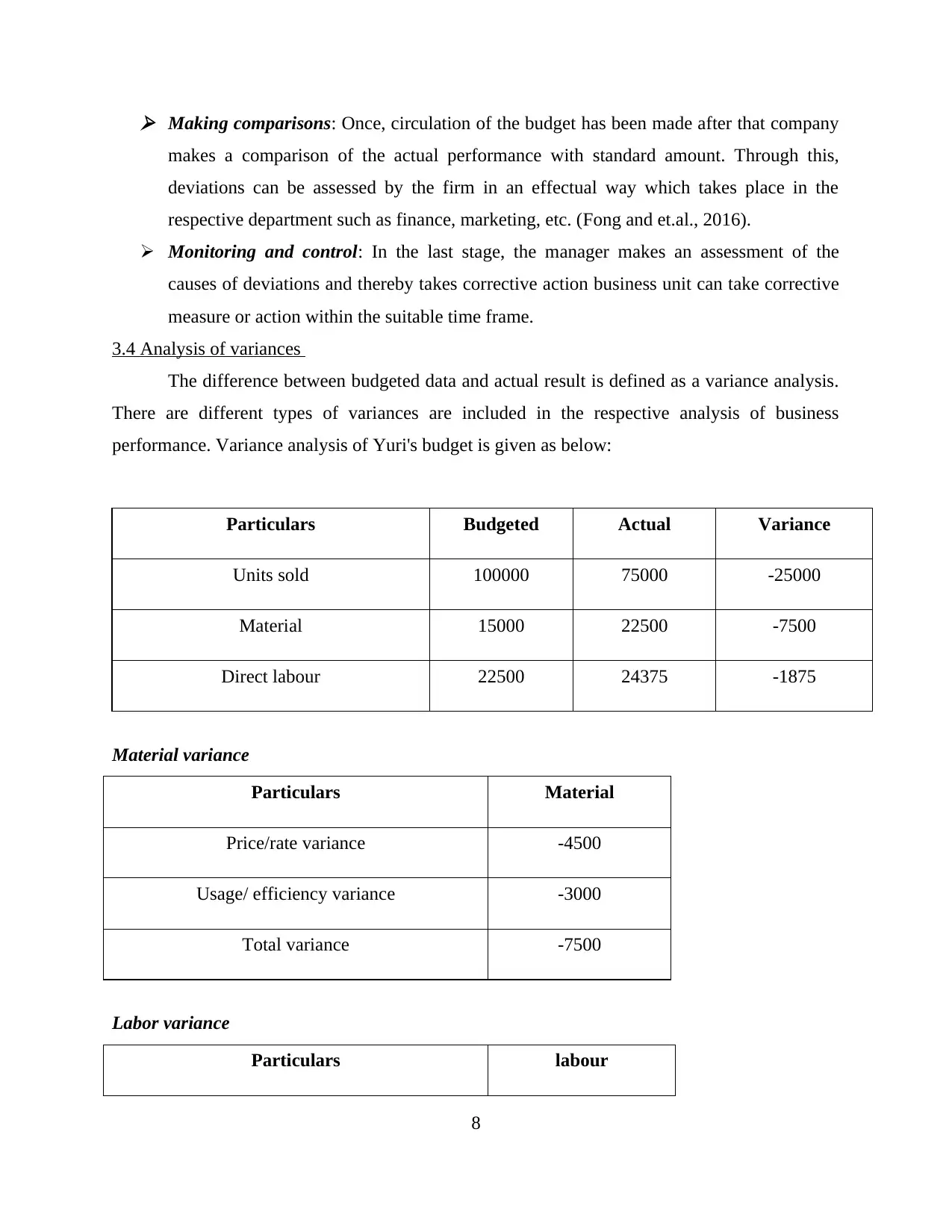
Making comparisons: Once, circulation of the budget has been made after that company
makes a comparison of the actual performance with standard amount. Through this,
deviations can be assessed by the firm in an effectual way which takes place in the
respective department such as finance, marketing, etc. (Fong and et.al., 2016).
Monitoring and control: In the last stage, the manager makes an assessment of the
causes of deviations and thereby takes corrective action business unit can take corrective
measure or action within the suitable time frame.
3.4 Analysis of variances
The difference between budgeted data and actual result is defined as a variance analysis.
There are different types of variances are included in the respective analysis of business
performance. Variance analysis of Yuri's budget is given as below:
Particulars Budgeted Actual Variance
Units sold 100000 75000 -25000
Material 15000 22500 -7500
Direct labour 22500 24375 -1875
Material variance
Particulars Material
Price/rate variance -4500
Usage/ efficiency variance -3000
Total variance -7500
Labor variance
Particulars labour
8
makes a comparison of the actual performance with standard amount. Through this,
deviations can be assessed by the firm in an effectual way which takes place in the
respective department such as finance, marketing, etc. (Fong and et.al., 2016).
Monitoring and control: In the last stage, the manager makes an assessment of the
causes of deviations and thereby takes corrective action business unit can take corrective
measure or action within the suitable time frame.
3.4 Analysis of variances
The difference between budgeted data and actual result is defined as a variance analysis.
There are different types of variances are included in the respective analysis of business
performance. Variance analysis of Yuri's budget is given as below:
Particulars Budgeted Actual Variance
Units sold 100000 75000 -25000
Material 15000 22500 -7500
Direct labour 22500 24375 -1875
Material variance
Particulars Material
Price/rate variance -4500
Usage/ efficiency variance -3000
Total variance -7500
Labor variance
Particulars labour
8
Paraphrase This Document
Need a fresh take? Get an instant paraphrase of this document with our AI Paraphraser
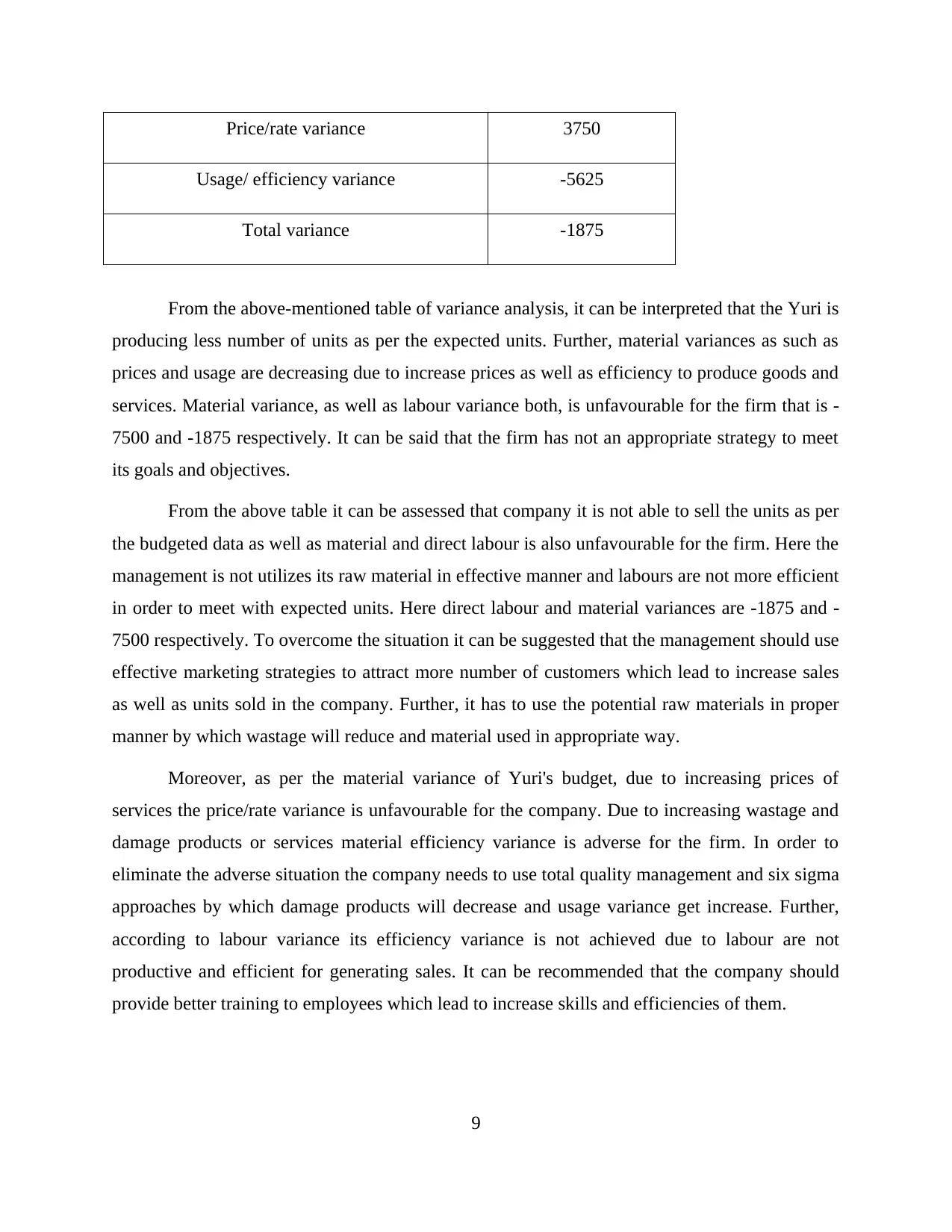
Price/rate variance 3750
Usage/ efficiency variance -5625
Total variance -1875
From the above-mentioned table of variance analysis, it can be interpreted that the Yuri is
producing less number of units as per the expected units. Further, material variances as such as
prices and usage are decreasing due to increase prices as well as efficiency to produce goods and
services. Material variance, as well as labour variance both, is unfavourable for the firm that is -
7500 and -1875 respectively. It can be said that the firm has not an appropriate strategy to meet
its goals and objectives.
From the above table it can be assessed that company it is not able to sell the units as per
the budgeted data as well as material and direct labour is also unfavourable for the firm. Here the
management is not utilizes its raw material in effective manner and labours are not more efficient
in order to meet with expected units. Here direct labour and material variances are -1875 and -
7500 respectively. To overcome the situation it can be suggested that the management should use
effective marketing strategies to attract more number of customers which lead to increase sales
as well as units sold in the company. Further, it has to use the potential raw materials in proper
manner by which wastage will reduce and material used in appropriate way.
Moreover, as per the material variance of Yuri's budget, due to increasing prices of
services the price/rate variance is unfavourable for the company. Due to increasing wastage and
damage products or services material efficiency variance is adverse for the firm. In order to
eliminate the adverse situation the company needs to use total quality management and six sigma
approaches by which damage products will decrease and usage variance get increase. Further,
according to labour variance its efficiency variance is not achieved due to labour are not
productive and efficient for generating sales. It can be recommended that the company should
provide better training to employees which lead to increase skills and efficiencies of them.
9
Usage/ efficiency variance -5625
Total variance -1875
From the above-mentioned table of variance analysis, it can be interpreted that the Yuri is
producing less number of units as per the expected units. Further, material variances as such as
prices and usage are decreasing due to increase prices as well as efficiency to produce goods and
services. Material variance, as well as labour variance both, is unfavourable for the firm that is -
7500 and -1875 respectively. It can be said that the firm has not an appropriate strategy to meet
its goals and objectives.
From the above table it can be assessed that company it is not able to sell the units as per
the budgeted data as well as material and direct labour is also unfavourable for the firm. Here the
management is not utilizes its raw material in effective manner and labours are not more efficient
in order to meet with expected units. Here direct labour and material variances are -1875 and -
7500 respectively. To overcome the situation it can be suggested that the management should use
effective marketing strategies to attract more number of customers which lead to increase sales
as well as units sold in the company. Further, it has to use the potential raw materials in proper
manner by which wastage will reduce and material used in appropriate way.
Moreover, as per the material variance of Yuri's budget, due to increasing prices of
services the price/rate variance is unfavourable for the company. Due to increasing wastage and
damage products or services material efficiency variance is adverse for the firm. In order to
eliminate the adverse situation the company needs to use total quality management and six sigma
approaches by which damage products will decrease and usage variance get increase. Further,
according to labour variance its efficiency variance is not achieved due to labour are not
productive and efficient for generating sales. It can be recommended that the company should
provide better training to employees which lead to increase skills and efficiencies of them.
9
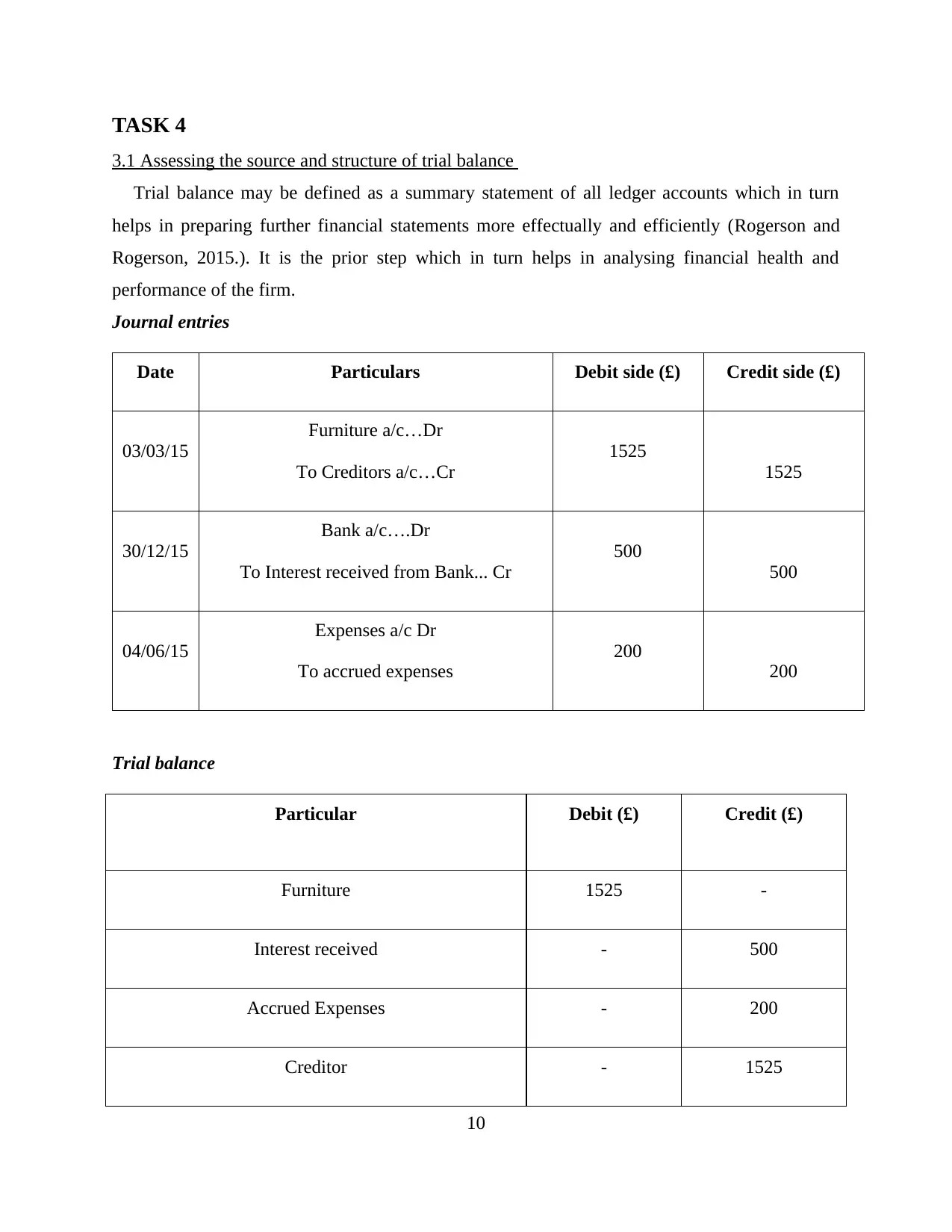
TASK 4
3.1 Assessing the source and structure of trial balance
Trial balance may be defined as a summary statement of all ledger accounts which in turn
helps in preparing further financial statements more effectually and efficiently (Rogerson and
Rogerson, 2015.). It is the prior step which in turn helps in analysing financial health and
performance of the firm.
Journal entries
Date Particulars Debit side (£) Credit side (£)
03/03/15
Furniture a/c…Dr
To Creditors a/c…Cr
1525
1525
30/12/15
Bank a/c….Dr
To Interest received from Bank... Cr
500
500
04/06/15
Expenses a/c Dr
To accrued expenses
200
200
Trial balance
Particular Debit (£) Credit (£)
Furniture 1525 -
Interest received - 500
Accrued Expenses - 200
Creditor - 1525
10
3.1 Assessing the source and structure of trial balance
Trial balance may be defined as a summary statement of all ledger accounts which in turn
helps in preparing further financial statements more effectually and efficiently (Rogerson and
Rogerson, 2015.). It is the prior step which in turn helps in analysing financial health and
performance of the firm.
Journal entries
Date Particulars Debit side (£) Credit side (£)
03/03/15
Furniture a/c…Dr
To Creditors a/c…Cr
1525
1525
30/12/15
Bank a/c….Dr
To Interest received from Bank... Cr
500
500
04/06/15
Expenses a/c Dr
To accrued expenses
200
200
Trial balance
Particular Debit (£) Credit (£)
Furniture 1525 -
Interest received - 500
Accrued Expenses - 200
Creditor - 1525
10
⊘ This is a preview!⊘
Do you want full access?
Subscribe today to unlock all pages.

Trusted by 1+ million students worldwide
1 out of 23
Related Documents
Your All-in-One AI-Powered Toolkit for Academic Success.
+13062052269
info@desklib.com
Available 24*7 on WhatsApp / Email
![[object Object]](/_next/static/media/star-bottom.7253800d.svg)
Unlock your academic potential
Copyright © 2020–2025 A2Z Services. All Rights Reserved. Developed and managed by ZUCOL.





